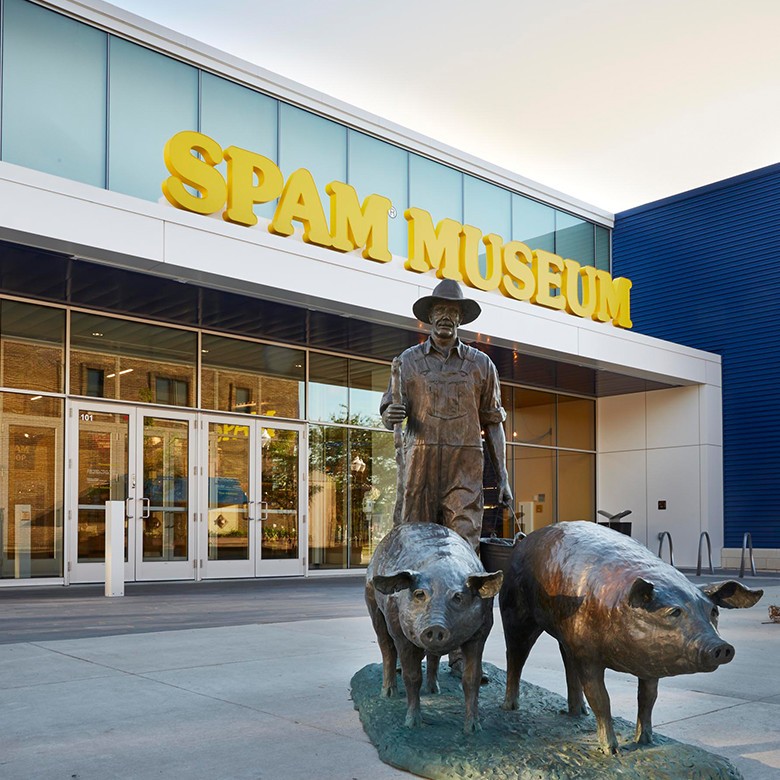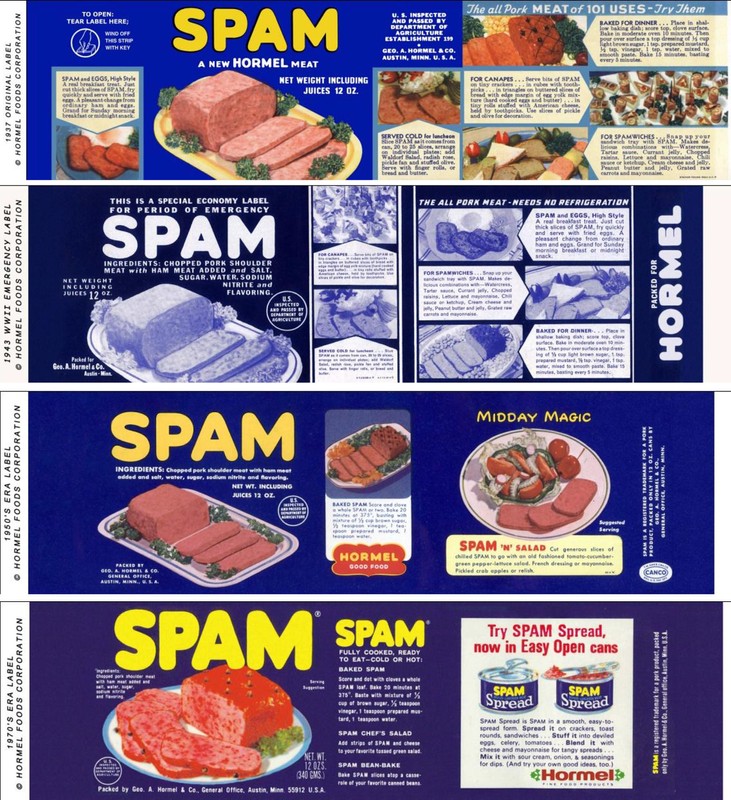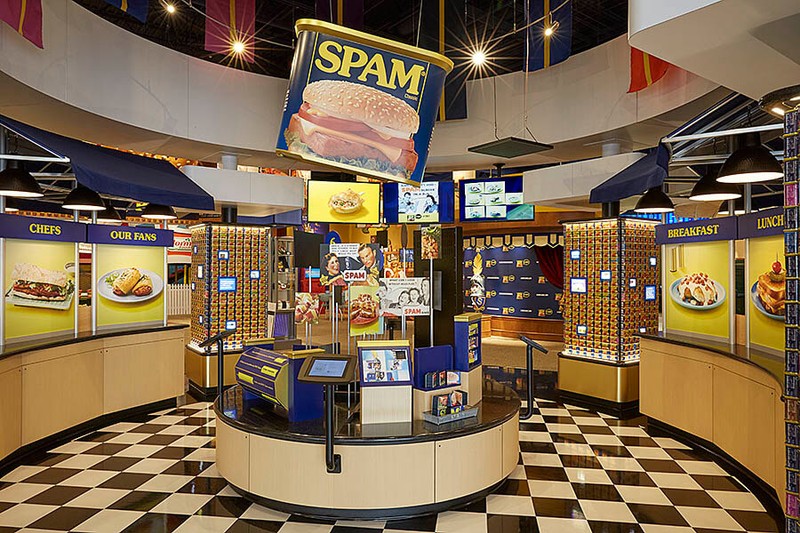Spam Museum
Introduction
Text-to-speech Audio
Images
First opening in 1991, the Spam Museum moved to its current location in downtown Austin in 2016. Image obtained from spam.com.

Spam was first marketed in 1937 as an inexpensive and versatile canned meat that could be prepared quickly and with little effort. Image obtained from eater.com.

The Spam Museum boasts 14,000 square-feet of displays and interactive exhibits. Image obtained from hormelfoods.com.

Part of the museum explains Spam's role in feeding millions of Allied troops during World War II. Image obtained from hormelfoods.com.

Backstory and Context
Text-to-speech Audio
The origins of the Hormel Foods Corporation date to 1891, when George A. Hormel opened a slaughterhouse and meatpacking facility in Austin, Minnesota. Around 1929, George’s son Jay Hormel took over the company and proceeded to try creating new food products. In 1937, Hormel introduced a canned meat made with pork, water, sugar, salt, and sodium nitrate (a sixth ingredient, potato starch, was added in 2009). The new product was named Spam, a combination of the words “spiced” and “ham” that was supposedly suggested by Kenneth Daigneau, the brother of a Hormel executive. Spam was first marketed to housewives as an inexpensive meal that did not have to be refrigerated and required little-to-no preparation.
Spam first became a global icon during World War II, when the American military began purchasing massive quanities of canned foods, including Spam, for troop rations. It is estimated that Hormel sent 100 million cans of Spam to U.S. and Allied forces during the war. Troops stationed in Hawaii and the Asian Pacific also introduced Spam to locals, where it became extremely popular and remains a staple of daily life in Hawaii and parts of Japan and South Korea. Spam was not poplar with everyone however, especially among troops who had to eat it frequently; Jay Hormel even revealed that he kept a folder of hate mail from American troops writing of their disdain for the canned meat.
Spam continued to remain popular after the end of the war. In the late 1940s and early 1950s Hormel employed a group of traveling singers called the Hormel Girls to promote the brand. By the 1960s it was being marketed more as an ingredient for different meals rather than a main dish. Many regional recipes have been developed around it, such as budae jigae (“army stew”), a Korean dish of Spam simmered with spices and broth. Today Spam has become an international pop culture icon. In Hawaii, the community of Waikiki now holds an annual “Spam Jam” street festival dedicated to the meat.
In 1991 Hormel Foods, in honor of its 100th anniversary, opened a small museum in Austin’s Oak Park Mall to showcase the company’s history. It was originally named the Hormel Foods First Century Museum, but was soon changed to the Spam Museum after visitors expressed an overwhelming interest in that particular product. The popularity of the museum compelled Hormel Foods to open a bigger one in a 16,500 square-foot facility at the company headquarters. In 2014 the museum was closed and moved to a new 14,000 square-foot building on 3rd Avenue NE. The decision to move was made in the hope that the new, more-accessible location would increase visitors and promote local businesses in downtown Austin.
The Spam Museum focuses on the history of Spam, how it is made, and its influence both on the American military and around the world. It includes a wall made of 3,390 cans of Spam, a Spam conveyor built moving throughout the building, and a collection of musical instruments made from Spam cans. There are exhibits depicting the early history of the Hormel company and the invention of Spam; the role of Spam in World War II; the evolution of Spam branding and advertising; a “World Market” exhibit showing the popularity of Spam in other countries such as Japan; and a “Changing Marketplace” exhibit that compares grocery stores of 1951 to the present day. The museum is notable for having many interactive exhibits as well, including nineteen video screens, live cooking demonstrations, and a mock assembly line where visitors can try canning Spam. Guides, known as “Spambassadors” give out free samples of Spam. There is also a gift shop onsite that sells a variety of Spam-themed souvenirs.
Sources
ABC News. “Spam turns 80 and here’s its story” (video). Originally aired May 11, 1987, on ABC. Posted July 5, 2017. Accessed January 14, 2018. http://abcnews.go.com/Lifestyle/video/spam-turns-80-story-48449692.
CBS Sunday Morning. “In Hawaii, Spam goes with everything” (video). Posted November 23, 2014. Accessed January 14, 2018. https://www.youtube.com/watch?v=xuLsGm3X54M.
DeJesus, Erin. “A Brief History of Spam, an American Meat Icon.” Eater. July 9, 2014. Accessed January 14, 2018. https://www.eater.com/2014/7/9/6191681/a-brief-history-of-spam-an-american-meat-icon.
Hormel Foods. “SPAM Museum” (video). Posted July 6, 2017. Accessed January 14, 2018. https://m.youtube.com/watch?v=drEl6cZyFS0.
“Hormel Foods Opens New SPAM Museum in Downtown Austin.” Hormel Foods. April 22, 2016. Accessed January 14, 2018. https://www.hormelfoods.com/newsroom/press-releases/hormel-foods-opens-new-spam-museum-in-downtown-austin/.
Noel, Josh. “Spam Museum has new home in downtown Austin, Minn.” Chicago Tribune. April 22, 2016. Accessed January 14, 2018. https://www.chicagotribune.com/lifestyles/travel/sc-spam-museum-austin-travel-0503-20160422-story.html.
Ross, Jenna. “Canning its old location, Austin’s new Spam Museum opens.” Star Tribune. April 22, 2016. Accessed January 14, 2018. https://www.startribune.com/canning-its-old-museum-austin-s-new-spam-museum-opens-friday/376650361/#1.
“SPAM Museum.” Roadside America. Accessed January 14, 2018. https://www.roadsideamerica.com/story/2126.
Wang, Frances Kai-Hwa. “New 14,000-Square-Foot Spam Museum Opens in Minnesota.” April 27, 2016. Accessed January 14, 2018. https://www.nbcnews.com/news/asian-america/new-14-000-square-foot-spam-museums-opens-minnesota-n563436.
Waxman, Olivia B. “Spam is turning 80. Here’s How the Canned Meat Took Over the World.” Time Magazine. July 5, 2017. Accessed January 14, 2018. time.com/4827451/spam-history-80th-anniversary/.
Image 1: http://www.spam.com/images/9/f/c/9fc2f5e8a102d969eb4dc58e07df77bbf5d4b2b6/spam-pigs.jpg
Image 2: https://cdn.vox-cdn.com/uploads/chorus_asset/file/7058961/spam2.0.jpg
Image 3 and 4: https://www.hormelfoods.com/newsroom/press-releases/hormel-foods-opens-new-spam-museum-in-downtown-austin/
